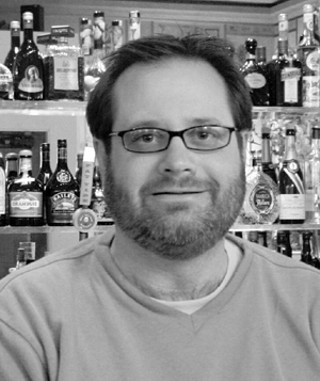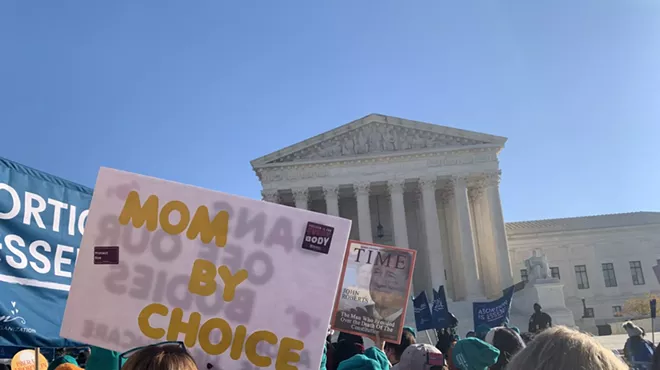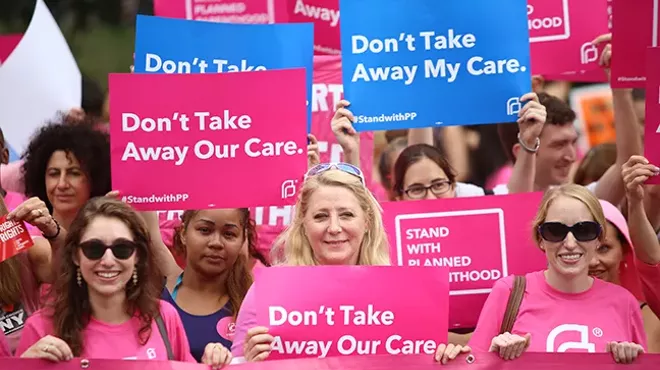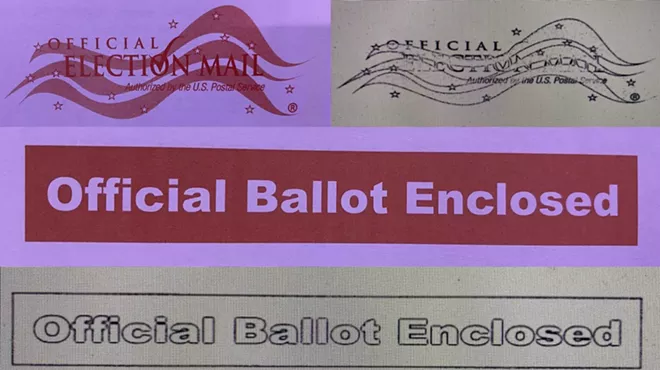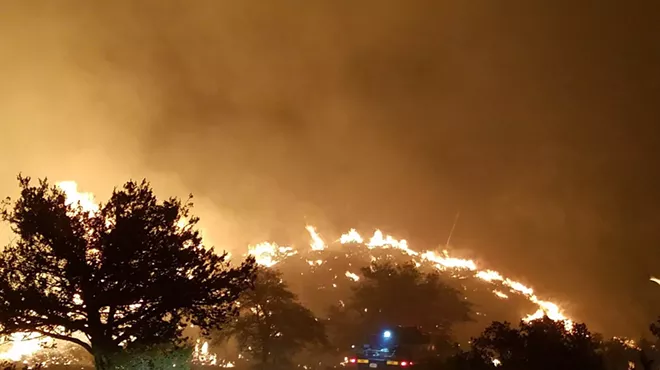Tuesday, February 19, 2013
Rothschild's State of the City: "The Problem of Poverty in Tucson Didn't Happen Overnight. Solutions Won't Either."
Tucson Mayor Jonathan Rothschild delivered his second State of the City today to a full room out at Starr Pass Resort.
The central takeaway of the speech (which you can read in its entirety below): We’re doing a little bit better, but we need to do a lot better—and we need to do it as a community. Tax revenues are up, but still not nearly what they were before the fiscal crash. The city is trying to be more welcoming to business (Rothschild was able to rattle off a long list of new businesses in Tucson), but we still need to make the process easier for them. The citizens of Tucson showed they had a little more trust in the city when they (narrowly) supported road bonds in last year’s election, but it’s going to take a long time to fix all those potholes. As Rothchild put it early on:
The challenges ahead, however, are daunting. The cost of providing quality public services is rising, and too many Tucsonans are still struggling. To meet the challenges facing our community, we must work together as a community. If I have learned one thing in 14 months as mayor, it is this: we do more together than alone.
Rothschild offered up hope for the future: He’s been working our neighbors in Mexico to create more trade opportunities in Southern Arizona. He’s hired a bunch of new department heads throughout the city. The city’s ongoing disputes with Rio Nuevo have been resolved (a line that got a lot of applause) and we’re seeing a boom in downtown. The city is partnering with the UA, IBM and others to get outside expertise.
He also offered up an agenda of putting more school-resource officers in schools, developing online courses to help high-school dropouts get GEDs, and improve literacy among Tucson’s residents.
Near the end of his speech, Rothschild seized upon a goal that many mayors before him have failed to deliver on: More annexation to reduce the number of people living in unincorporated Pima County. This effort has rarely gone well, but Rothschild urged not only Tucson but the surrounding suburbs to expand their boundaries in order to capture more state revenue. Rothschild admitted that it won’t be easy:
This problem of poverty in Tucson didn’t happen overnight. Solutions won’t either. Choices made decades ago, including choices not to pursue, or to resist, annexation, have helped bring us to where we are at today. I spoke of this last year, and since then the city has completed a handful of annexations, with more on the way. The City Council has committed additional resources to fund these efforts. To recapture the $70 million or more we lose in state-shared revenue every year, we must become an incorporated valley. Those dollars are our roads. Those dollars are our parks. Those dollars are our police and fire departments.I like our friends in Maricopa County as well as the next guy, but it is time we stopped building their roads, their parks, and their police and fire departments with our tax dollars.
This problem of the state sharing revenue based on population living in incorporated areas is not just Tucson’s problem. It’s a regional problem. That’s why I’m pleased to announce that the mayors of the four cities in our region who can do annexations—Oro Valley, Sahuarita, Marana, and Tucson—have committed to meet regularly, along with our managers, to cooperate in this effort. And we encourage our friends in Vail in their efforts to incorporate.
Finally, we invite Pima County to join us in actively encouraging annexation and incorporation. The role of counties, as set forth in state statute, does not change with annexation.
With an incorporated valley, all governments in the region get back more of their tax dollars. We could have more services, and lower property taxes, paid for with our own state-shared revenue.
We can no longer afford to do things that don’t make sense. Having urban and suburban areas that aren’t incorporated, giving $70 million back to the state every year, going without needed services, and making local businesses carry a higher property tax burden than businesses in other parts of the state—these things don’t make sense. Fortunately, the status quo does not have to be our destiny.
That’s a lengthy pullquote but it sums up why annexation makes regional sense from a financial standpoint, even if many of those residents who live in unincorporated Pima County probably enjoy not having to deal with a municipal government of some kind. The remarks also included an interesting tidbit about Vail’s effort at incorporation. In the past, the city of Tucson has generally tried to block neighboring communities from incorporating; now it’s encouraging it, at least out on the southeast side. (The City Council is set to pass a memorial in support of the Vail incorporation at tomorrow’s City Council meeting.)
Here's Rothschild's speech:
Ladies and gentlemen, welcome to the 2013 State of the City Address. Thank you for coming.I’d like to thank the Tucson Metropolitan Chamber of Commerce and the Marriott Starr Pass for hosting this year’s event. I’d especially like to thank the Chamber for giving part of today’s proceeds to three outstanding nonprofits: Habitat for Humanity, Literacy Connects and La Frontera.
Last year, at my first State of the City, I spoke about making Tucson work—putting people to work, making city government work.
Working together, we are making that happen.
In the fall of 2011, when I was elected, Tucson’s unemployment rate was 8.1%. Today, it is 6.9%. Retail sales tax revenues are up 7.6% from where they were a year ago. We’re making good progress. The challenges ahead, however, are daunting. The cost of providing quality public services is rising, and too many Tucsonans are still struggling. To meet the challenges facing our community, we must work together as a community. If I have learned one thing in 14 months as mayor, it is this: we do more together than alone.
Setting goals helps. I had a plan for my first 180 days in office. I followed that with a plan for my next 360 days.
I’d like to highlight some of what we’ve accomplished by working together—public, private and nonprofit sectors, as well as across departments and between organizations. In other words, what we’ve done as a community.
Our Economy
A big part of the mayor’s job is to work on attracting and retaining businesses in our community. Tucson needs a strong private sector in order to thrive and improve our quality of life. Last year, we welcomed a number of new businesses to our community: Acceler8, Aris Integration, Curacao, Involta, Living Social, Optum RX, ReCommunity, Smashburger, and TAP Royal, to name a few. Others, we congratulated on their expansion.
Businesses like Graybar, which opened a new, 55,000 square foot facility built to LEED “green” building standards. And businesses like Quik Trip, which opened its 100th Arizona store on Alvernon near 22nd. With all their experience doing business in Arizona, what did Quik Trip’s Director of Real Estate tell me about working with the city? That we’re—and I’m quoting—“easy to deal with,” and, “I can’t thank your people enough for helping to expedite the process.”
Process Improvements
That’s no accident. Working together with the business community, the city’s Planning and Development Services Department changed how it operated, cutting permitting time in half by reviewing site and improvement plans at the same time. And that’s not all. Today, the city cross-trains inspectors, allows approved design professionals to self-certify certain projects, and, in many cases, allows new businesses to use existing certificates of occupancy without having to apply for new ones.
We continue to make process improvements, not just in Planning and Development Services, but also in Finance and IT. All three departments, plus the city’s economic development team, are working together to redesign the city’s business web portal, to deliver more and better services to our constituents. Instead of waiting in line, you’ll be able to get what you need from the city online.
We’ve made it easier for local businesses to compete for city contracts. Working together with our Procurement Department, the City Council passed a local purchase ordinance, giving local businesses more opportunity to win city contracts. The City of Tucson wants to buy local.
Business Incentives
We’ve made it easy to find the 21 business incentives the city offers. The brochures at your tables outline these programs. We want your business in the city. This past year, two companies, American Tire Distributors and B/E Aerospace, used one of these programs, the city’s Primary Jobs Incentive, to expand. And we’re not stopping there. Our economic development team is looking for more ways to spur investment and create jobs here in Tucson.
One of the 21 incentives, the GPLET, was adopted last spring. By fall, the first development to use this program broke ground. One East Broadway, a 17.9 million dollar mixed-use high-rise, is being built by local contractor Caylor Construction.
The beauty of the GPLET is that it offers a guaranteed return to taxpayers, who must benefit more than the developer from the temporary tax abatement and have that verified by an independent third party.
When I discovered that other Arizona cities had successfully used GPLETs to build their downtowns, I asked our City Council to offer this incentive and they acted immediately. Already, these programs are attracting private investment.
And while we’re on the subject of downtown development, I want to acknowledge that, earlier this month, we settled all disputes between the Rio Nuevo District and the City of Tucson. The settlement creates a platform for moving forward. The Rio Nuevo Board and the City Council agree, we can do more together than alone.
Process improvements and incentives are part of the picture. Another part is going out and meeting with the business community, to keep the businesses we have and to bring new businesses to Tucson. My business advocate, our economic development team, and I meet personally with CEOs whenever possible.
Of course, I also meet with representatives of major employers who are already here— particularly those in our Southern Economic Corridor, such as Raytheon and Davis-Monthan. Aerospace and defense are important economic drivers in our region. The success of Tucson International Airport and its neighbors, Raytheon, Bombardier, the ANG, and others, is vital to our continued economic growth.
International Trade
I’ve also worked to increase international trade, tourism, and investment in Tucson. With the support of our City Council, I’ve made several trips to Mexico, meeting with business, industry, and government leaders. I’ve toured manufacturing sites in Guaymas and Empalme, where more than 30 multi-national corporations have operations. Our city has led in regional diplomacy, changing the conversation in this state about Mexico, and that has been a good thing.
My goal in all this is to bring regional headquarters and logistics operations to Tucson. Our location gives Tucson an advantage as a hub for international trade between the United States and Mexico and, via the deep-water port in Guaymas, between the United States and Asia.
Location is an advantage, but it is not a guarantee. For Tucson to be a hub for international trade, we need the right infrastructure at the border, for security and speed. Other states have already discovered that trade with Mexico means prosperity for their region. We are in competition for that trade, and the stakes are high. We cannot afford a bottleneck at the border where the expanded Mariposa Port of Entry in Nogales connects with I-19. Expansion means more trade, and I’ve been making the case to the Department of Homeland Security, the Arizona Department of Transportation and the Federal Highway Administrator for increased investment in technology, personnel, and highway infrastructure at the border.
I’m asking our regional partners, PAG, MAG and CAAG—the Pima, Maricopa and Central Arizona Associations of Governments—to work together on this. We need to develop a plan that gives us the infrastructure to be competitive as an international trade route, by interstate and rail, including the rail yard near Red Rock.
This is some of what we’re working on, together, to help our economy. Next, city services.
Our City Services
When I took office, many city departments were without directors. The city’s Department of Transportation and the Tucson Convention Center each had serious administrative problems.
In 14 months, the city has hired a Human Resources Director, an Economic Development Director, an Environmental Services Director, an IT Director, a Risk Manager, a Transportation Director, and a Water Director. A number of temporary appointments have also been made, with interim directors in Housing and Community Development, Procurement, and at the TCC. And, of course, directing city administration in his quiet, firm and experienced way, City Manager Richard Miranda.
The city is rebuilding its economic development team, and has recently hired an International Trade Specialist. This is as it should be. We continue to work with our regional partners, but businesses coming to Tucson need points of contact in the city—to troubleshoot, if necessary— and the city needs its own people to make the case for locating inside city limits.
Rebuilding Trust
Financial and operational controls have been put in place at Parkwise, Transportation, and the TCC. We have a new City Manager and a new Mayor. I hope it is clear to everyone that we expect excellence in all our endeavors.
We know we’re in a period of rebuilding trust in city government. We owe that to the people of Tucson and we owe it to the overwhelming majority of city employees who work hard every day and do good work. I start every day by responding to citizens’ questions and requests. By constantly communicating, we will continue to build trust.
In last year’s State of the City, I said that improving the condition of city streets was a top priority. Systematically, we cleaned up our medians. Then, we asked voters to approve Prop. 409 to fix our streets. Yes, the vote was close, but it passed—a good sign that we are rebuilding trust. We’ve told Tucsonans what roads we’re going to fix and when, and that an independent citizens’ committee will provide oversight. This is the way bonds should be administered, and we are committed to keeping our promises to the people of Tucson.Along with streets, we’ve worked to secure funding for bike paths and pedestrian walkways inside city limits—over 4.5 million dollars—from the RTA.
Partnerships
We’ve done much internally, but because we do more together than alone, the city has reached out to others to improve our services.
We’re partnering with the University of Arizona on several initiatives. We’re working with the College of Architecture to rebuild the city’s Planning Department. If we are to move beyond strip-mall development and sprawl, to transit-oriented development and infill, we need development, land use, and planning expertise.
We’re working with the University’s Office of Technology Transfer and Tech Launch Arizona to help turn breakthrough discoveries into breakout companies that create jobs here in Tucson.
We’re working with IBM, which awarded Tucson a Smarter Cities Challenge grant to help Tucson Water better use the massive amount of data it receives every day. The grant has two goals: to help consumers spot problems before they get billed for them and to help Tucson Water save on energy costs of pumping water, which are substantial.
We’re working with the business community, through associations like the Metro Chamber. You see one result of that on your tables today, our Joint Business Objectives. The city is committed to ensuring excellent services for all our constituencies, and the business community is no exception.
Transit
We continue to work with our regional transit and transportation partners: Sun Tran, the RTA, and PAG. The city was fortunate to hire the RTA’s Director of Transit Services, Carlos de Leon, as our Deputy Director of Transportation. Carlos will work on creating a path to sustainability for our city’s transit system, increasing revenues and reducing expenses. All of us—TDOT, Sun Tran and our City Council—will need to think in new and creative ways when it comes to transit services. No city makes money off its transit system. But walking away from providing public transportation is not an option. There are too many benefits transit provides: better air quality, less traffic congestion, and mobility for those who don’t drive or have a car.
We‘re meeting with representatives of the University of Arizona and Pima Community College to see how we can offer Sun Tran and Sun Link services to our student population. We need to increase ridership among people who choose transit, not because they have to, but because they want to. The streetcar, Sun Link, can help us meet this goal. That’s in addition to the private investment generated along its route and the tens of millions of federal dollars brought to our city’s construction industry, just when we needed it most.
School Resource Officers
While a city the size of Tucson must provide transit, our number one obligation remains public safety.
There too, we face challenges. We must rethink how best to deliver services. But one goal is within reach. When I ran for office, one of the programs I campaigned on was bringing School Resource Officers back to Tucson schools. This was well before the horror at Newtown.
SROs serve a number of functions. Unlike armed guards or school personnel, SROs are sworn police officers who have extensive, ongoing training in firearms and tactical operations.
But my goal for the program was simpler. SROs are a form of community policing. The officer is a role model for students—someone to reach out to with problems at school, or at home, and prevent those problems from escalating into violence. I am pleased that President Obama and Governor Brewer agree, and have committed to provide funding for SROs. I look forward to having SROs back in some Tucson schools.
Public/Private Partnerships
There was a time when cities had more resources, and funded more programs, than today. While we continue to rebuild our economy, we realize we won’t see a return of that former largesse. Municipalities, across the country, are finding that their financial situation limits them to funding core services.
Cities are responding by becoming more creative and collaborative. Tucson is no exception.
Last year, Tucson’s Parks and Recreation Department opened a number of pools it had been forced to close. Since public safety is job one for city government, our parks department had absorbed more than its share of cuts. City pools were reopened using a public-private partnership called Bring Back the Splash. Again, I’d like to thank our community partners who made this possible. We’ve continued the program this year and hope to open the same pools again, plus one more, this summer.
Our Community
While municipalities no longer have the discretionary funds they used to, they still play an important role in building community. A mayor is in a unique position to mobilize people and resources. And, if we’re to be successful as a community, it’s more important than ever that the mayor bring people and groups to work together.
I’ve formed Advisory Task Forces on Education, Health and Wellness, Poverty, Seniors and Youth. We also have Working Groups; one on refugees, started by Bishop Kicanas; one on our re-entry population, with Council Member Richard Fimbres; and one on STEM education. These ad hoc groups give people and organizations a way to work together on some of our most challenging issues. I want to thank everyone who participates. All are volunteers giving their time.Education
Today, I would like to focus on three of the Task Forces: Education, Health and Wellness and Poverty.
Without an educated workforce, we can’t attract the businesses we want. We can’t retain the businesses we have. Education is a business issue.
Our Education Task Force is working with programs that help our young children become capable readers and that help our young adults stay in school, or go back and get their diplomas.
Dropping out of high school often means dropping into poverty, a problem for the community as well as the dropout.
Working together with the Sunnyside School District, my office recently announced the launch of GradLink, a flexible, online learning program to help recent dropouts go back and get their diplomas. As we work through this pilot project, I hope to see this, or similar programs, become available to more students and more school districts.
3rd grade is when students go from learning to read to reading to learn. Students who don’t reach this milestone are likely to remain poor readers, and much more likely to drop out.
Next fall, a new state law takes effect, requiring 3rd graders who don’t pass the reading portion of the AIMS test to repeat 3rd grade. According to the most recent National Assessment of Educational Progress, 42% of Arizona 4th graders read at a level below basic. Just 26% are proficient readers. We have work to do, as a community, to turn this around—and turn it around we must.
As our United Way focuses on funding local literacy programs, our Education Task Force is focused on recruiting volunteer tutors for those programs. Our goal: to add several hundred tutors this year. Today, I ask each of you, your companies, your community and faith organizations, to join in this effort. A literate, educated community is our path to prosperity.
Personally, I’m visiting classrooms and reading to children on a regular basis. Tucson’s Poet Laureate, Rebecca Seiferle, is doing the same, using poetry to get kids excited about reading and writing. We’ll be making PSAs in English and Spanish, and using robo-calls to reach out to parents to let them know what reading resources are available. Working together with the Pima County Public Library, we’re launching the Mayor’s Reading Challenge—another way we’re promoting reading.
Health and Wellness
Just as education has economic implications for a community, so does health and wellness. Healthy lifestyles reduce medical costs for individuals, employers, and communities. And we know they improve our quality of life.
Our Health and Wellness Task Force is working on increasing access to healthy foods and safe places to exercise. We’ve launched Walk 100 Miles with the Mayor. To fight childhood obesity, children under 18 who walk or run 100 miles before June 1st will receive an award at the TMC Meet Me Downtown 5k. Anyone can participate. Already, Tucsonans have logged over 10,000 miles since the program was launched six weeks ago.
Mental health is as important as physical health, but getting access to care can be much more difficult. Today, I’m announcing the formation of a Mental Health Working Group, chaired by Dan Ranieri and Clarke Romans, to look at how best to address the needs of this population.
Cities often deal with those who have fallen through the social safety net. We do so with our paramedics and police, through our courts, and with our parks and housing departments. We are not alone in this task. Counties have responsibility for workforce development, health care, and jails. Nonprofits, too, provide many services. So do neighbors, helping neighbors.
Good Neighbor Ventures is one group that’s bringing neighbors and local businesses together to help meet community needs—reading with youth, bringing the elderly out of isolation. Neighbors supporting local businesses, and local businesses supporting their neighborhoods— this is how we become a more connected community.Poverty
A year ago, at this luncheon, I announced the formation of my first Task Force, on Poverty.
Their first order of business was to help create a coordinated entry system for the homeless to access social services, a HUD requirement making it easier to track and deliver services, as well as to reduce the time spent homeless. The goal is to return folks to permanent housing within 30 days.
Because Tucsonans have already been working together on this—the Veteran’s Administration, the City’s Department of Housing and Community Development, Primavera, Our Family Services, Habitat for Humanity, and many others—the Obama Administration has selected Tucson as one of 25 priority communities to end veteran’s homelessness by 2015 and to end child and family homelessness by 2020. It’s a tall order, but we welcome this challenge from Washington to be a national leader in eliminating homelessness.
Annexation and Incorporation
This past year, we received the unwelcome news that Tucson is the 6th poorest metropolitan area in the nation. There are a lot of Tucsonans who cannot afford the basics. To me, this means that government cannot afford to do things that don’t make sense. If we are to transform our community, we must be relentless in refusing to accept the status quo where that no longer makes sense.
This problem of poverty in Tucson didn’t happen overnight. Solutions won’t either. Choices made decades ago, including choices not to pursue, or to resist, annexation, have helped bring us to where we are at today. I spoke of this last year, and since then the city has completed a handful of annexations, with more on the way. The City Council has committed additional resources to fund these efforts. To recapture the $70 million or more we lose in state-shared revenue every year, we must become an incorporated valley. Those dollars are our roads. Those dollars are our parks. Those dollars are our police and fire departments.
I like our friends in Maricopa County as well as the next guy, but it is time we stopped building their roads, their parks, and their police and fire departments with our tax dollars.
This problem of the state sharing revenue based on population living in incorporated areas is not just Tucson’s problem. It’s a regional problem. That’s why I’m pleased to announce that the mayors of the four cities in our region who can do annexations—Oro Valley, Sahuarita, Marana, and Tucson—have committed to meet regularly, along with our managers, to cooperate in this effort. And we encourage our friends in Vail in their efforts to incorporate.
Finally, we invite Pima County to join us in actively encouraging annexation and incorporation. The role of counties, as set forth in state statute, does not change with annexation.
With an incorporated valley, all governments in the region get back more of their tax dollars. We could have more services, and lower property taxes, paid for with our own state-shared revenue.
We can no longer afford to do things that don’t make sense. Having urban and suburban areas that aren’t incorporated, giving $70 million back to the state every year, going without needed services, and making local businesses carry a higher property tax burden than businesses in other parts of the state—these things don’t make sense. Fortunately, the status quo does not have to be our destiny.
Conclusion
I’ve said we do more together than alone. Let me give you one last example of what I mean.
Today, we have a better way to do CPR, thanks to collaboration between the University of Arizona’s Sarver Heart Center and the Tucson Fire Department. The survival rate for traditional CPR is low. Firefighters asked researchers, “Help us do better.”
And they did. The new, Continuous-Chest-Compression CPR is far more effective than traditional CPR for sudden cardiac arrest.
Collaboration made this possible. Firefighters needed researchers to develop the technique; researchers needed firefighters to test it in the field.
We do more together than alone.
It didn’t end there. Once the results were in, those involved reached out—to fire departments, hospitals, medical schools and other organizations.
Including the Girl Scouts, who have a camp—Camp Fury—that teaches 4th and 5th graders about firefighting. Northwest and Tucson Fire Departments help out, teaching first aid and the new Continuous-Chest-Compression CPR.
One of those Girl Scouts remembered the technique, years later, in high school, and used it to save her friend’s life when he collapsed after band practice in sudden cardiac arrest.
Because these people, these groups, worked together—because they sought, found and shared best practices with each other—Erika Yee was able to save Chris Miller’s life. Erika, Chris, please stand and be recognized. We are so glad to have you both here with us.
Tucson is a community where people care for one another. It is a great strength of our city. It is a strength we must draw upon in deciding what services we want, how best to deliver them, and how to pay for them, while meeting our existing obligations. Cities across the country, particularly older cities, like Tucson, face structural challenges in the years ahead. To meet these challenges, we must grow our economy and deliver services in new, creative and collaborative ways.
Tucsonans show our common bond in how we help one another—and also in how we come together to create our future. Tucson’s future, our shared destiny, is our common bond. We must build that future by working together.
Thank you for your time today. Thank you for your efforts on behalf of Tucson every day. Thank you for allowing me the great privilege of serving as your mayor. Thank you.


